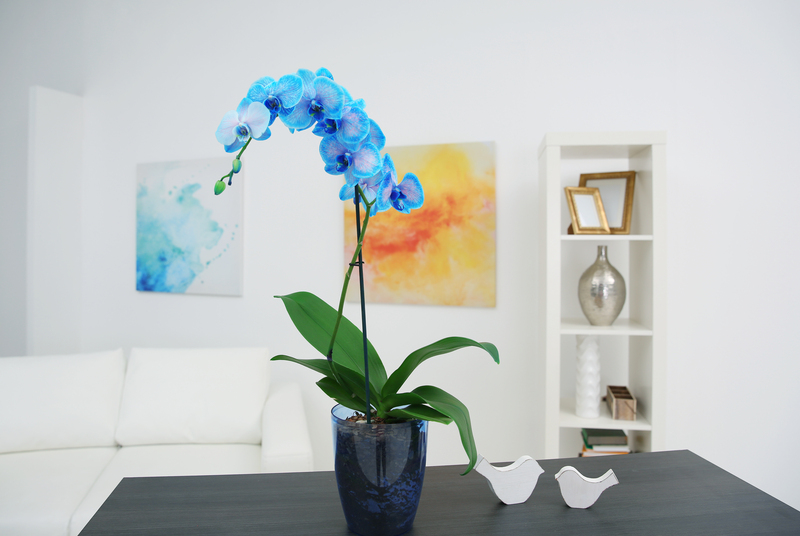Simple and Budget-Conscious Garden Solutions
Posted on 22/08/2025
Simple and Budget-Conscious Garden Solutions: Transform Your Outdoor Space Affordably
Gardening is one of life's simplest pleasures, offering peace, fresh air, a sense of accomplishment, and--even on a tight budget--a beautiful outdoor haven. Whether you're an urban dweller with a small balcony or have a more spacious backyard, implementing budget-friendly garden solutions can turn your outdoor dreams into reality. In this comprehensive guide, we'll explore simple, cost-effective ideas that help you cultivate a thriving garden without breaking the bank.

Why Choose Simple and Budget-Conscious Garden Solutions?
A well-maintained garden doesn't require a fortune or professional landscaper. Embracing budget-conscious gardening lets you enjoy several advantages:
- Save money while cultivating fresh fruits, vegetables, and herbs.
- Promote sustainability through upcycling, recycling, and eco-friendly practices.
- Foster creativity by reusing everyday items as planters or decor.
- Encourage well-being through outdoor activity and connection with nature.
Below are multiple clever ways to maximize your gardening efforts with minimal investment.
1. Upcycled and DIY Planters: Save Money & Add Personality
Buying new pots and planters can quickly add up. Repurpose household items to create unique and environmentally friendly planters:
- Old boots and shoes: Give worn footwear a new life by filling them with soil and your favorite blooms.
- Plastic bottles: Cut and decorate bottles to use as hanging or wall-mounted planters.
- Tins and cans: Paint food cans and punch drainage holes for rustic herb pots.
- Wooden crates or pallets: Stack or mount them to fashion vertical gardens or raised beds.
Tip: Always ensure proper drainage to prevent root rot.
2. Propagate Plants from Cuttings: Multiply Your Greenery for Free
Instead of buying new plants each season, utilize plant propagation to stretch your budget. Many common plants are easy to grow from cuttings, seeds, or division:
- Herbs: Mint, basil, oregano, and rosemary root easily in water.
- Succulents: Break off healthy leaves; let the ends dry, then plant them for new growth.
- Perennials: Divide clumping or spreading varieties (like hostas and daylilies) in spring or fall.
Pro tip: Connect with neighbors or local gardening groups for plant swaps and bolster your garden for free!
3. Composting: Create Rich Soil Without Buying Fertilizer
Simple compost bins can be made from repurposed wood, plastic bins, or even a designated corner of your yard. Compost transforms kitchen scraps and yard waste into nutrient-rich soil that invigorates your plants.
- Collect vegetable peels, coffee grounds, eggshells, leaves, and grass clippings.
- Avoid adding meat, dairy, or oils to deter pests.
- Turn your compost pile weekly to speed up decomposition.
Budget-conscious garden solutions always include making your own compost--nature's original (and free) fertilizer.
4. DIY Raised Beds and Garden Borders
Raised beds are perfect for maximizing small spaces and controlling soil quality. Instead of buying expensive materials, try:
- Reused bricks or stones: Define the borders of your garden beds for a polished look.
- Untreated wooden pallets: Stack and anchor for instant raised beds.
- Old tires: Paint and stack for a quirky garden bed--just ensure they're in an area not used for food crops due to potential chemical leaching.
Helpful Hint: Search online marketplaces (like Craigslist or Facebook Marketplace) for free or discounted materials to further cut costs.
5. Affordable Watering Solutions
Water is vital, but it doesn't have to soak your wallet. Try these simple garden watering ideas:
- Rain barrel collection: Place a barrel or large bucket under downspouts to gather rainwater for your plants.
- Self-watering bottles: Insert recycled plastic bottles (with holes in the cap) upside down into the soil for slow, deep watering.
- Mulching: Lay straw, shredded leaves, or grass clippings around plants to retain soil moisture and reduce watering frequency.
Conserving water fits both budget and environmental priorities, making it an essential budget-conscious garden solution.
6. Seeds Over Starts: Grow More, Spend Less
Seed packets are far more affordable than starter plants and often yield dozens--or even hundreds--of plants. For the best results:
- Start seeds indoors in recycled containers (such as yogurt cups or egg cartons).
- Label seedlings with homemade tags from popsicle sticks or cut-up plastic containers.
- Follow local planting guides to ensure seeds sprout at the right time for your climate.
Garden seeds provide maximum value and a wider variety of plant options compared to buying mature starts.
7. Thrifty Garden Decor Ideas
You don't have to splurge on pricey sculptures or lighting to make your garden inviting. Consider these budget-friendly garden decorations:
- Fairy lights: Repurpose indoor string lights for twinkling ambiance.
- Homemade stepping stones: Pour concrete or use flat stones for a quaint walkway.
- Decorative stones and painted rocks: Children can help paint bright designs to scatter throughout the beds.
- Wind chimes: Make your own using old cutlery, keys, or shells.
8. Efficient Layouts: Maximize Every Inch for Less
Whether your garden is large or tiny, thoughtful planning is key. Use these layout strategies to save money and effort:
- Companion planting: Pair plants that nourish each other (e.g., tomatoes and basil) to reduce pests and improve yields.
- Vertical gardening: Use trellises, shelves, or stacked planters to grow upward, perfect for small spaces.
- Succession planting: Plant quick-maturing crops in stages to ensure a steady harvest and maximize bed usage.
These simple garden layouts result in higher yields and a more vibrant, aesthetically pleasing space.
9. Sourcing Free or Low-Cost Supplies
Great gardens thrive on resourcefulness. Before buying supplies, get creative with your sourcing:
- Local community groups: Search Freecycle, Facebook groups, or community boards for plant and supply giveaways.
- Public seed libraries: Many libraries and botanical gardens offer free seeds to share and swap.
- Yard sales and thrift stores: Often have used tools, pots, and furniture at a fraction of retail prices.
- Neighborhood clean-up days: Collect discarded materials for building and planting projects.
Frugal garden solutions often start with a bit of local networking and community involvement.
10. Low-Maintenance and Resilient Plant Choices
Choosing the right plants for your climate and soil is crucial for saving time and money. Opt for:
- Native plants: Adapted to local conditions and require less water, fertilizer, and maintenance.
- Drought-tolerant species: Like sedum, lavender, and yarrow for hot or dry regions.
- Perennials: Plants that return each year, eliminating the need to replant.
Tip: Native wildflowers and grasses can attract bees, butterflies, and birds, increasing biodiversity naturally.
11. Practical, Budget Gardening Tools
High-quality gardening tools can be a significant expense, but you can keep it simple:
- Borrow or share rarely-used tools with neighbors.
- Shop for sturdy, second-hand tools at garage sales or thrift shops.
- Use household items--old kitchen spoons as trowels, milk jugs as watering cans--to improvise.
- Maintain tools by cleaning and oiling to extend their life and performance.
Personal touch: Customizing or decorating your DIY tools can add character to your gardening experience!
12. Inexpensive Garden Pest Control
Commercial pesticides and repellents can drain your budget and harm the environment. Try these low-cost, natural options:
- Soap spray: Mix water with a few drops of dish soap to deter aphids and mites.
- Hand-picking: Removing pests by hand is effective for small gardens.
- Attract beneficial insects: Plant marigolds and alyssum to invite lacewings and ladybugs.
- Physical barriers: Lay netting or row covers to protect crops without chemicals.
13. Smart, Budget-Friendly Weeding Techniques
Weeds compete for nutrients and water, but keeping them under control doesn't have to be expensive:
- Homemade weed killer: Mix vinegar, salt, and a drop of dish soap, then spray directly on weeds (be careful to avoid garden plants).
- Mulching: Suppress weeds organically with straw, woodchips, or newspaper.
- Regular hand-weeding: A few minutes a week saves hours later and is free exercise.
14. Seasonal and Rotational Gardening: Keep Costs Down All Year
Schedule your planting and rotate crops to keep your garden productive and healthy without constant input costs:
- Plant cool-weather crops in spring and fall (lettuce, spinach, peas) and warm-season crops in summer (tomatoes, beans, cucumbers).
- Rotate vegetable beds yearly to minimize disease and pest build-up.
- Start new seeds as others are harvested for continuous fresh produce.

Conclusion: Start Your Simple and Budget-Conscious Garden Today!
With the right garden solutions, anyone can enjoy lush green spaces and homegrown produce--regardless of space, experience, or budget. The ideas above are designed to keep gardening simple, fun, and most importantly, affordable. By choosing DIY approaches, upcycling materials, and sourcing plants and supplies creatively, your garden can flourish with minimal cost and maximum satisfaction.
Remember, a budget-friendly garden not only enriches your surroundings but also offers valuable lessons in sustainability, self-sufficiency, and creativity. Start small, be resourceful, and let your garden grow along with your imagination and expertise!
FAQs About Budget-Conscious Gardening
- What is the cheapest way to start a backyard garden? Start with seeds, use compost from kitchen scraps, and repurpose materials for planters and beds.
- How can I garden if I have no yard? Container and vertical gardens can make great use of balconies, patios, and windowsills.
- Are there ways to garden year-round on a budget? Use cold frames, row covers, and succession planting for longer harvests without costly greenhouses.
- Where can I find free or cheap plants? Connect with local plant swaps, join a seed library, or propagate from neighbors' cuttings.
Get started today--your dream garden doesn't need to cost a fortune!

